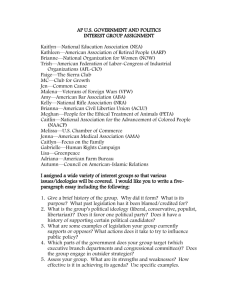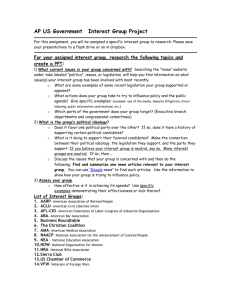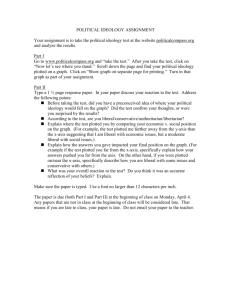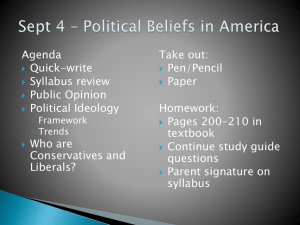Political Culture and Ideology
advertisement
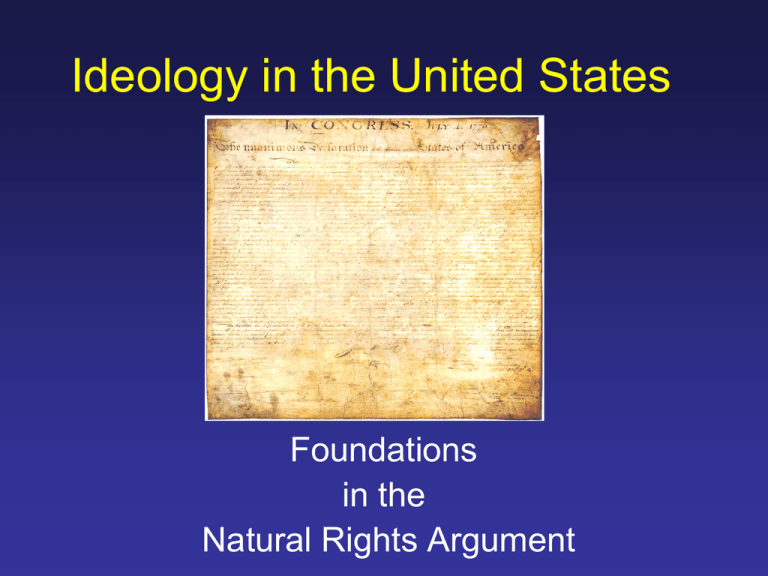
Ideology in the United States Foundations in the Natural Rights Argument Major Themes of the Declaration of Independence Self evident truths We hold these truths to be self-evident Human equality All men are created equal They are endowed by their Creator with certain unalienable rights Natural rights Among these rights: Life Liberty Pursuit of happiness Purpose of gov’t To secure rights Measure of Justice Consent of the governed Right of revolution Limits to the right of revolution Whenever any form of gov’t is destructive of the security of natural rights Prudence: Long-established gov’ts shouldn’t be overthrown for “light and transient causes” Experience: Men are more disposed to suffer while evils are sufferable than to right themselves Political Culture v. Ideology • Political Culture • A set of general attitudes, ideas and beliefs • Broadly informs and shapes a region’s politics • Ideology • A set of specific attitudes, ideas and beliefs • Provides or advocates a coherent plan for social, political, or economic action Examples of ideologies • Economic ideologies • Political ideologies – – – – – – – – – Libertarianism Liberalism Conservatism Anarchism Socialism Fascism Communism Communitarianism Statism – – – – – – – capitalism communism globalism protectionism Keynesianism monetarism Market fundamentalism • Social ideologies – – – – – – Tribalism Ethnocentrism Nationalism Feminism Multiculturalism Supremacism What ideology Is • A set of specific ideas, attitudes and beliefs • Provides or advocates a coherent plan for social, political, or economic action • Plan is consistent with, and is explained in terms of, the ideas, attitudes and beliefs held What ideology is not: • Ideology is not political culture – Traditionalists are not necessarily conservatives – Liberals are not necessarily moralists • Ideology is not partisanship – Democrats are not necessarily liberal – Republicans are not necessarily conservative • Ideology is not a policy position – E.g. Abortion • advocates are not necessarily libertarian or liberal • opponents are not necessarily conservative or libertarian – E.g. Immigration • “Open border” advocates are not necessarily libertarian globalists • “Closed border” advocates are not necessarily conservative ethnocentrists Comparative Ideology 1: Left and Right Wings Motto of the French Revolution: Liberté, Egalité, Fraternité (liberty, equality, brotherhood) Origins in the FrenchAdvocates National Assembly of Revolutionary Advocates of Liberté sympathetic Libertéand andFraternité, Egalité, opposing the toancien the distinction ancien régime, satonto on the This grafted the régime (the Old Order) right of theofroom American Congress inthe theroom early sat on theside left side 19th Century Left and Right: The Political Spectrum The most common comparative model of ideological preference in the US Left Wing Communism Socialism Liberalism Centrism Conservatism Statism Right Wing Fascism Comparative Ideology 2: The Political Compass ? • • • • First suggested in Jerry Pournelle’s Doctoral dissertation in 1964 Appeared in Meltzer, Albert and Stuart Christie. The Floodgates of Anarchy. (London: Sphere Books, Ltd., 1970) Seeks to address limitations of the Political Spectrum Describes two independent dimensions: – Moral: Individualism to Collectivism – Economic: Capitalism to Collectivism • Clarified for American audiences in 1971 by David Nolan – Economic Freedom v. Economic Control – Personal Freedom v. Social Control • • Favored by those whose ideologies do not fit well with the Political Spectrum, especially libertarians Widely used by online political actors, pundits & campaigners Limits of the Political Compass • • • • • • Equates policy positions with ideology in their tests (See the Nolan Quiz) – Identifies attitudes on “personal” and “economic” issues – Does not identify organizing principles or the general purpose of government Ill-equipped to distinguish moderates from extremists – communists from welfare liberals – anarchists from libertarians – fascists from conservatives Does not distinguish one kind of “centrist” or “moderate” from another Fails to identify some known ideological positions – Communitarianism – Anarcho-communism – Anarcho-syndicalism – Nazism (with its fascist rhetoric and anarchist means) Unable to account for real linkages within its framework – liberal-leaning conservatives – conservative-leaning liberals Assumes liberals and conservatives are opposites Comparative Ideology 3: Ideological Space • Suggested by Steven Kautz in 1995: “enduring controversies regarding the nature of popular government give rise to three distinct strains: – liberals (who love liberty) – democrats (who love equality) – republicans (who love virtue)” • Problems with Kautz’ formulation “Ideologies…map the political and social worlds for us. We simply cannot do – Order more fundamental than virtue without them because cannot actpolitical without making sense of the worlds we • Political “virtue”we depends on the order it inhabits inhabit.” Michael Freeden, Ideology: Very Short Introduction. Oxford UP,debate 2003. – Kautz’ vision clouded by theA American partisan/ideological • “Liberal” has different meanings inside and outside the US • “liberal” is an ideology • “democrats” and “republicans” are coalition political parties in the US • Alternative principles of ideological preference – Liberty – Equality – Order Liberty, Equality, Order • Widely held political principles – Regardless of expressed ideology – Held in different proportion by different ideological adherents • Ideologies can be identified by different proportional attachment to or rejection of these three principles – Suggests measurability – Attachment to: positive ideology – Rejection of: negative ideology • May be used to describe an ideological map with three axes – Liberty – Equality – Order LEO Space Three axial principles (Dimensions) Liberty Equality Order Six levels Describe distance from ideological center Centrist Moderate Ideologue Hard-Liner Radical Extremist Ideological Regions in LEO Space 1. 2. 3. 4. 5. 6. 7. 8. L+E+O+ (Standard Ideological Preference) L-E+O+ (Anti-libertarian) L+E-O+ (Anti-egalitarian) L-E-O+ (Anti-libertarian and Anti-egalitarian) L+E+O- (Anti-establishmentarian) L+E-O- (Anti-communitarian) L-E+O- (Anti-libertarian and Anti-establishmentarian) L-E-O- (Universal Opposition) Most ideological preferences found in only 1st region LEO Made Simple Principle Centrist Ideology Libertarian Centrist Libertarian Left Libertarian Right Libertarian Liberal Centrist Liberal (US), Labour (UK) Liberal Egalitarian Liberal Communitarian Conservative Liberal Liberty Equality Moderate Ideology Conservative Centrist Conservative Libertarian Conservative Order Conservative Communitarian Liberal Conservative Radical or Extreme Ideology Anarchist Anarcho-Communist Anarcho-Syndicalist Socialist Communist Statist Fascist Other Ideologies in LEO • Communitarianism – Equal parts Equality and Order – Liberty subordinate • The Reagan Coalition – Equal Parts Liberty and Order – Equality subordinate • Thomas Hill Green’s Welfare Liberalism – Equal Parts Liberty and Equality – Order subordinate Critique of the LEO Model • Advantages – – – – – – – Identifies a wider range of ideologies than either Spectrum or Compass Suggests linkages between ideologies Renders ideological claims testable Distinguishes mere negative opposition from true preference Predicts accusations of extremism by opponents Independent of policy position Independent of partisan assumptions • Disadvantages – – – – – Complexity Abstraction Potentially awkward or unfamiliar ideological nomenclature Posits potentially absurd ideological possibilities Still unable to explain Nazism (fascist rhetoric, anarchist means)
